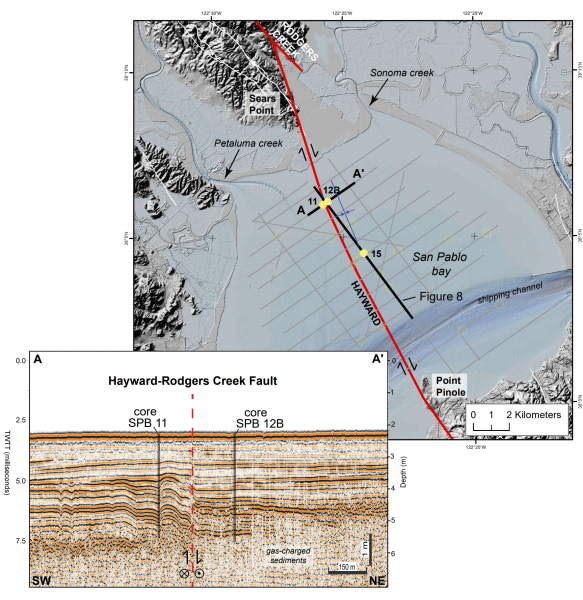Marine Paleoseismic Evidence for Seismic and Aseismic Slip Along the Hayward-Rodgers Creek Fault System in Northern San Pablo Bay
Janet Watt
USGS Pacific Coastal and Marine Science Center

- Date & Time
- Location
- Online-only seminar via Microsoft Teams
- Summary
Distinguishing between seismic and aseismic fault slip in the geologic record is difficult, yet fundamental to estimating the seismic potential of faults and the likelihood of multi-fault ruptures. We integrated chirp sub-bottom imaging with targeted cross-fault coring and core analyses of sedimentary proxy data to characterize vertical deformation and slip behavior within an extensional fault bend along the Hayward-Rodgers Creek fault system in northern San Pablo Bay. We identified and traced four key seismic horizons (R1–R4), all younger than approximately 1400 CE, that cross the fault and extend throughout the basin. A stratigraphic age model was developed using detailed down-core radiocarbon and radioisotope dating combined with measurements of anthropogenic metal concentrations. The onset of hydraulic mining within the Sierra Nevada in 1852 CE left a clear geochemical and magnetic signature within core samples. This key time horizon was used to calculate a local reservoir correction and reduce uncertainty in radiocarbon age calibration and models. Vertical fault offset of strata younger than the most recent surface-rupturing earthquake on the Hayward fault in 1868 CE suggest near-surface vertical creep is occurring along the fault in northern San Pablo Bay at a rate of approximately 0.4 mm/yr. In addition, we present evidence of at least one and possibly two coseismic events associated with growth strata above horizons R1 and R2, with median event ages estimated to be 1400 CE and 1800 CE, respectively. The timing of both these events overlaps with paleoseismic events on adjacent fault sections, suggesting the possibility of multi-fault rupture.
Closed captions are typically available a few days after the seminar. To turn them on, press the ‘CC’ button on the video player. For older seminars that don’t have closed captions, please email us, and we will do our best to accommodate your request.
 Jump to Navigation
Jump to Navigation